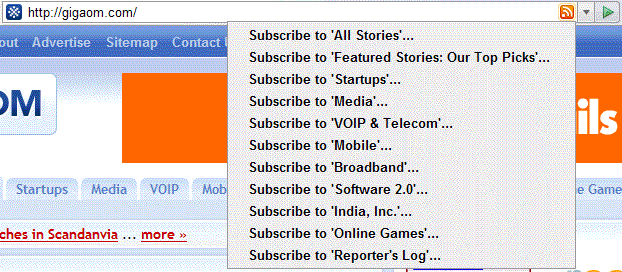RSS Autodiscovery
Editor's Note: This is version 1.0 of this document, published Nov. 27, 2006.
1. Introduction
RSS autodiscovery is a technique that makes it possible for browsers and other software to automatically find a site's RSS feed, whether it's in RSS 1.0 or RSS 2.0 format.
Supported by Mozilla Firefox 2.0, Microsoft Internet Explorer 7.0 and other browsers, autodiscovery has become the best way to inform users that a web site offers a syndication feed. When a browser loads a page and discovers that a feed is available, Firefox and Internet Explorer display the common feed icon in the address bar.
![]()
Users can click the icon to subscribe with the browser's RSS reader or the user's preferred reader. Web publishers who offer feeds reach a wider potential audience with autodiscovery.
This specification describes how web publishers can support autodiscovery by adding an HTML header to web pages.
2. Conventions
In this documentation, the key words may, must, must not, optional, recommended, required, shall, shall not, should and should not are to be interpreted as described in RFC 2119.
3. link Element
Autodiscovery employs the link element from HTML and XHTML to identify a site's syndication feed. The link must be placed within a web page's head element to establish a relationship between the page and another document.
To support autodiscovery, a link element must be added to the header, as shown in this HTML markup from The RSS Blog:
<html>
<head>
<title>The RSS Blog</title>
<link rel="alternate" type="application/rss+xml" title="RSS"
href="http://feeds.feedburner.com/TheRssBlog">
</head>
<body>
<!-- the web page's contents -->
</body>
</html>
The link can be placed within the header of the site's home page, individual pages such as weblog entries and any other page where a user might want to know that a feed's available. A head may include more than one autodiscovery link, but each must identify a different feed.
To make the RSS subscription process simple for inexperienced users, publishers should include only one autodiscovery link per page, using it to identify a site's main feed.
If you decide to include more than one autodiscovery link, the first link should be the site's main feed.
Publishers who offer the same feed content in several syndication formats should not use autodiscovery links for all of them. Choosing only one feed format for autodiscovery makes it easier on new subscribers, especially if they are unfamiliar with syndication and can't distinguish between the Atom, RSS 1.0 and RSS 2.0 formats.
The link element must have three attributes that describe the relationship: href, rel and type and may have a title attribute.
Because attribute names must be lowercase in XHTML, autodiscovery link attributes should have lowercase names in HTML as well.
3.1. href Attribute
The href attribute must be the feed's URL. This can be a relative URL in pages that include a base element in the header.
<head>
<title>RSS Advisory Board</title>
<base href="https://www.rssboard.org/">
<link rel="alternate" type="application/rss+xml" href="rss-feed">
</head>
Because some software might not check for a base URL in relation to autodiscovery links, publishers should identify feeds with full URLs. When an autodiscovery link is relative and no base URL has been provided, clients should treat the web page's URL as the base.
3.2. rel Attribute
The rel attribute must have a value of "alternate", a keyword that indicates the link is an alternate version of the site's main content.
Although for purposes other than autodiscovery this attribute may contain multiple keywords separated by spaces, in an autodiscovery link, the value must not contain keywords other than "alternate".
Additionally, though rel keywords are case-insensitive elsewhere, "alternate" must be lowercase.
3.4. title Attribute
The title attribute, when present, contains be a short, human-readable label such as the site's name or the feed's name. When a page contains more than one autodiscovery link, the title enables users to differentiate between the feeds, as demonstrated by Om Malik's GigaOM site.

Each autodiscovery link has a different title, which Mozilla Firefox displays in a drop-down menu when a user clicks the common feed icon.
3.3. type Attribute
The type attribute must contain the feed's MIME type, which is "application/rss+xml" for RSS 1.0 or RSS 2.0 feeds.
Although type values are case-insensitive for other HTML and XHTML links, the value must be lowercase for autodiscovery.
3. Credits
Rogers Cadenhead, James Holderness and Randy Charles Morin contributed to this document. Comments and corrections regarding this document are encouraged on the RSS-Public mailing list.
4. License
Copyright 2025 RSS Advisory Board. This document titled RSS Autodiscovery is authored by the RSS Advisory Board, published at the URL https://www.rssboard.org/rss-autodiscovery and shared under the terms of the Creative Commons Attribution/Share Alike license.
